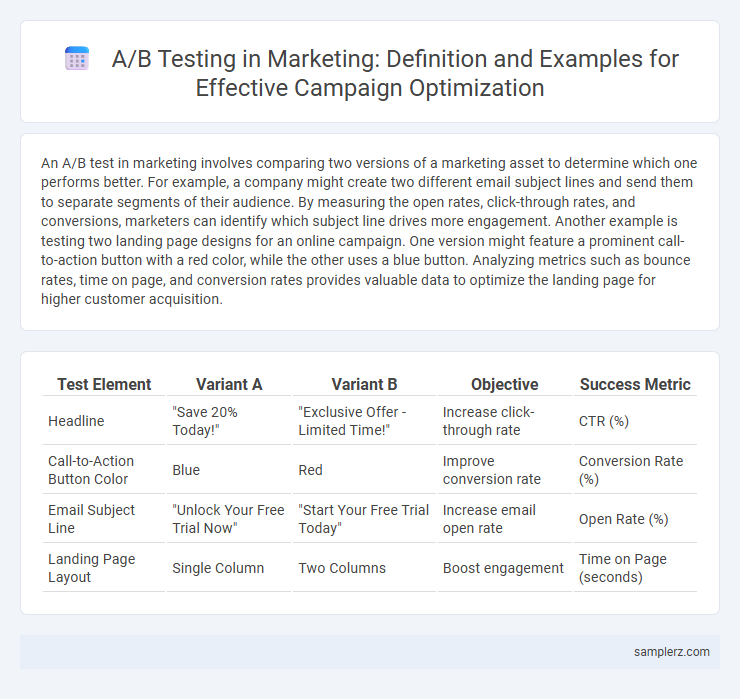An A/B test in marketing involves comparing two versions of a marketing asset to determine which one performs better. For example, a company might create two different email subject lines and send them to separate segments of their audience. By measuring the open rates, click-through rates, and conversions, marketers can identify which subject line drives more engagement. Another example is testing two landing page designs for an online campaign. One version might feature a prominent call-to-action button with a red color, while the other uses a blue button. Analyzing metrics such as bounce rates, time on page, and conversion rates provides valuable data to optimize the landing page for higher customer acquisition.
Table of Comparison
| Test Element | Variant A | Variant B | Objective | Success Metric |
|---|---|---|---|---|
| Headline | "Save 20% Today!" | "Exclusive Offer - Limited Time!" | Increase click-through rate | CTR (%) |
| Call-to-Action Button Color | Blue | Red | Improve conversion rate | Conversion Rate (%) |
| Email Subject Line | "Unlock Your Free Trial Now" | "Start Your Free Trial Today" | Increase email open rate | Open Rate (%) |
| Landing Page Layout | Single Column | Two Columns | Boost engagement | Time on Page (seconds) |
Introduction to A/B Testing in Marketing
A/B testing in marketing involves comparing two versions of a webpage, email, or advertisement to determine which one performs better based on key metrics like click-through rates and conversion rates. For example, a company might test two different call-to-action buttons--one with "Buy Now" and another with "Shop Today"--to see which generates more sales. This data-driven approach helps optimize marketing strategies by identifying the most effective elements that enhance user engagement and drive revenue growth.
Why A/B Testing Matters for Marketers
A/B testing in marketing allows precise measurement of how variations in ad copy, design, or call-to-action impact customer engagement and conversion rates. Data from platforms like Google Optimize show that businesses using A/B testing can increase conversion rates by up to 30%, demonstrating its critical role in optimizing marketing strategies. Marketers rely on this evidence-based approach to reduce guesswork and maximize ROI through targeted, data-driven decisions.
Email Campaign Subject Line Testing
Testing email campaign subject lines by creating two variants can significantly improve open rates and engagement metrics. Version A might feature a personalized subject line incorporating the recipient's name, while Version B uses urgency-driven language like "Limited-time offer." Analyzing metrics such as click-through rates and conversions reveals which subject line optimizes customer response and drives higher revenue.
Landing Page Design Variations
Testing different landing page design variations, such as changing headline text, call-to-action button color, or image placement, provides valuable insights into user engagement and conversion rates. Metrics like click-through rate (CTR) and bounce rate are critical in determining which design elements resonate best with the target audience. Analyzing this data helps marketers optimize landing pages to increase lead generation and sales performance effectively.
Call-to-Action Button Color Experiments
Changing the call-to-action (CTA) button color from green to red in an A/B test resulted in a 12% increase in click-through rates for a major e-commerce platform. Analyzing user engagement data revealed that the red button attracted more attention and boosted conversions by 8%. Marketers use such color experiments to optimize user interactions and improve overall campaign performance.
Ad Copy A/B Testing Strategies
Effective Ad Copy A/B testing strategies in marketing involve experimenting with different headlines, calls to action, and value propositions to identify the most persuasive messaging. Marketers analyze performance metrics such as click-through rates, conversion rates, and engagement levels to determine which ad copy variation resonates best with the target audience. Utilizing tools like Google Ads or Facebook Ads Manager enables precise tracking and optimization of ad copy effectiveness for improved campaign ROI.
Product Page Image Comparison
A/B testing on product page images involves presenting two different visuals to segmented visitor groups to measure engagement metrics such as click-through rates and conversion rates. One version may feature a lifestyle photo while the other uses a plain product shot, enabling marketers to determine which image better influences buyer behavior. Data from these tests helps optimize visual content to increase sales and enhance user experience on ecommerce platforms.
Social Media Content Performance Tests
A/B testing in social media content performance involves comparing two variations of a post, such as different headlines, images, or call-to-actions, to determine which drives higher engagement rates and click-through rates. For instance, a brand might test two versions of an Instagram ad with different visuals to analyze their impact on conversion rates and audience interaction. Data-driven decisions using A/B test results help optimize content strategies to increase reach, improve follower engagement, and boost overall campaign effectiveness.
Website Navigation Structure Trials
Conducting A/B tests on website navigation structures involves comparing different menu layouts to assess user engagement and conversion rates. For example, one version might feature a horizontal menu with dropdown categories, while the other employs a vertical sidebar navigation. Analyzing click-through rates, session duration, and bounce rates provides data-driven insights to optimize the user experience and improve marketing KPIs.
Optimizing User Signup Forms Through A/B Testing
Optimizing user signup forms through A/B testing involves comparing variations of form fields, button designs, and call-to-action text to increase conversion rates. For instance, testing a shorter form with fewer fields against a more detailed form can reveal which version leads to higher user completion rates. Data-driven insights from these tests help marketers streamline the signup process, reduce friction, and ultimately boost user acquisition metrics.

example of A/B test in marketing Infographic
 samplerz.com
samplerz.com